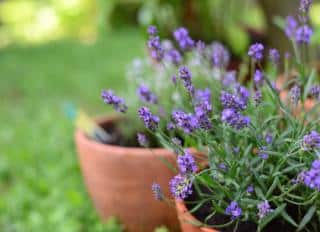

Easy to grow, lavender lets us savor the sun through its fragrance. Swaying at the tip of long scapes, its blue, violet or white panicle-shaped flower spreads delicious smells throughout the garden and produce abundant nectar that attracts bees.
The earliest lavender blooms as early as May, and if staged-blooming varieties are subtly arranged near each other, their beautiful blooms will fill the garden of delicious fragrances until the end of summer. A bunch of lavender stays in bloom for over a month, and is still very ornamental even after the blooming.
Lavender is happy in any light and well-drained soil, not necessarily rich, and rather chalky. Poor dry soil, with rocks is also fine.
But it really likes sun. Try to favor a warm location.
 Plant your lavender preferably in spring, after the last frost spells.
Plant your lavender preferably in spring, after the last frost spells.In Summer, you’ll notice many butterflies fluttering about to drink its nectar, such as the pearl-white cabbage moth.
A bunch of lavender in Italian-style terra cotta looks amazing.

Chose a 12 inch (30 cm) container that has a volume roughly double that of the clump.
Peat and bark soil mix mixed in with one-third coarse river sand suits most varieties well.
Never use a pot that has a water retention system, and check that drainage holes at the bottom of the pot are fine.
Trimming is required, but very easy to perform. In March-April, before new flower scapes appear, cut the previous year’s flower-bearing growth back to about an 1 inch (3 cm) from where they branched off.
Use short-bladed trimming shears. Try to keep a round shape. Cut the top off younger plants, less than three years old, to ensure they branch out well so that they won’t grow thick, hard stems.
Weed diligently around young lavender plantations. Organic matter mulch, cocoa hulls mulch or flax straw mulch is recommended.
Water only when the soil is really dry.
Here is our video advice to prune lavender correctly